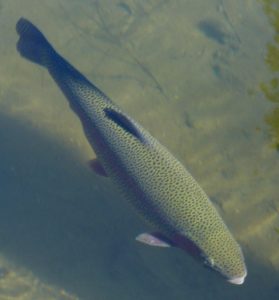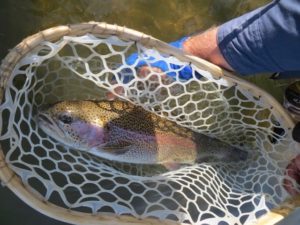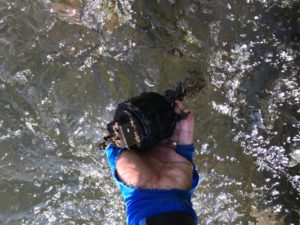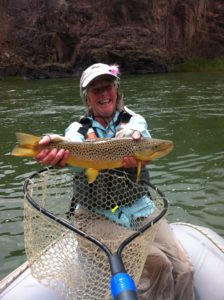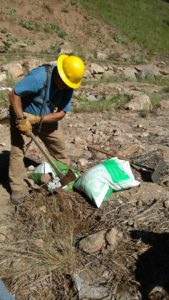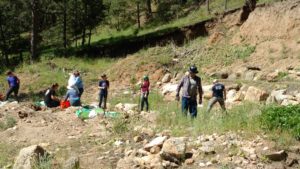Home waters.
For Colorado rancher Paul Bruchez, the phrase means more than a favorite local fishing stretch, although that’s part of it.
His home waters encompass a larger vision of waters that bind a community, and a way of life.
He’s spent much of his life along the Upper Colorado River, which winds through his family’s ranch near Kremmling and waters the pasture that supports the family’s cattle operation.
Paul also is a part-time fishing guide in the valley. “Only a rancher would be smart enough to supplement their income by being a fly-fishing guide,” he deadpans.
He loves ranching and fishing, and grew up immersed in both, but he knows this way of life depends on the river—and for decades, the Colorado River here has been in decline. Because of transmountain diversions to Front Range cities, drought, and other factors, he watched as the river dropped, leaving local ranchers’ irrigation pumps high and dry.
To his credit, Bruchez quickly realized that this was more than an irrigation problem. He found a study by a Colorado parks biologist that described seriously degraded river habitat in this stretch, including the loss of key health indicators such as riffle structures and stoneflies. In recent decades, the riffles and bugs had disappeared and been replaced with silt, steep eroded banks and what Bruchez calls “frog water”—slow, murky and mossy.
Looking at the degraded stretch left Bruchez wondering, “What happened to our river?”
So, a few years ago, he decided to do something about it. He talked with his neighbors about not just fixing their irrigation systems but actually fixing the river. Instead of replumbing the irrigation down to reach the river, he had the audacious idea of bringing the river levels back up. He wanted to restore flows and habitat for miles in the valley. He wanted a healthy river.
He began talking with Trout Unlimited and American Rivers. They put their heads together and came up with some innovative ideas. They launched a pilot project: on a neighbor’s ranch just outside of Kremmling, the partners brought in gravel and rocks to rebuild a point bar and reconstruct a riffle: the idea was to boost the oxygen in the water and provide cooler refuge for trout in the pool. Upstream of the riffle V, the narrower channel would back up the water, raising levels and making it more available for irrigation intakes.
At least that was the idea. Then they built it, and surprise—it worked.
The new riffle.
Bruchez likes to look at the riffle, which froths and rattles over gravel and then slides into a deep long run and is a thing of beauty. “It looks fishy now,” he says.
Almost immediately, the bugs came back. In fact, he recently scooped up a Mason jar of the big stoneflies and other bugs—like some homegrown canned goods—and took them to a meeting of the Colorado Basin Roundtable, a local water planning group for the state. Paul held up the jar and said: This is what river conservation success looks like. With a little help, he told them, the bugs will return, and with them, the foundation of the entire food chain in the river.
He and his neighbors now have funding to improve 10 miles of the river with riffle-pool structures and other habitat projects.
“These bugs will replenish themselves fairly quickly once the river is restored,” he says. And the trout will follow.
It’s working—in fact, it’s astonished him how quickly nature has responded to their efforts. A few weeks back, he took a Colorado senator to the original riffle project. As they looked at the rippling water and tailout, trout began popping everywhere on the surface, rising to a prolific bug hatch.
It was incredible timing. The senator was impressed.
Those rising trout were a vision of the future.
He holds on to those moments, because restoring home waters isn’t always glamorous work. He’s put in countless hours in recent years attending godawfully long planning meetings and crunching the mind-numbing details of construction budgets. He credits his family for covering for him on some of the ranching duties, allowing him to pursue his river work. His wife has been patient.
They understand it’s about keeping their family in this valley. Home waters.
Paul knows that their life here always comes back to the river. He wants to keep it flowing. He wants to keep it fishing. He wants to turn over rocks at the riffle’s edge and find crawling signs of life. That’s what victory looks like.
For more pictures and story on the Bruchez ranch project, read the upcoming issue of This is Fly Magazine.
The author of this piece, Randy Scholfield, is TU's director of communications for the Southwest.






